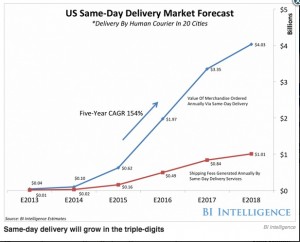Same-day delivery continues to generate a lot of buzz in the industry. Check out the following developments in just the past few months:
- Macy’s, Inc. Outlines New Developments in Omnichannel Strategy and Technology
- Target tries out same-day delivery service in select markets (Retailing Today)
- Amazon Same-Day Delivery Selection Grows in New York (Re/Code)
- Inside Google’s Big Plan to Race Amazon To Your Door (Re/code)
- Uber Corner Store
- Zipments Acquires Hobson to Become the Leading Same-Day Delivery Provider for Retailers in NYC
But how big is the same-delivery market and how fast is it growing? The folks at BI Intelligence published a report this week, and they estimate that about $100 million of merchandise will be ordered via same-day delivery in 2014, generating about $20 million in shipping fees (the analysis covers just 20 U.S. cities). By 2018, they predict that $4.03 billion of merchandise will be ordered via same-day delivery (a 5-year CAGR of 154 percent), generating a little over $1 billion in shipping fees.

I haven’t seen the full report, so I don’t know what data and assumptions BI Intelligence used to create this forecast, but like all all forecasts, it will likely turn out to be wrong one way or another — especially since the same-day delivery market (and the B2C segment in particular) is still relatively new. And as noted in the Business Insider article, “Despite all the competition in the same-day delivery market, it still won’t be easy to get people to pay for these services. 92% of consumers say they are willing to wait four days or longer for their e-commerce packages to arrive.”
What do you think of BI Intelligence’s forecast for the same-delivery market? Too high, too low, or just right? Post a comment and share your perspective!
For related commentary on same-day delivery, read these Talking Logistics posts:
- Debunking the Myths of Same-Day Delivery (Or What Amazon Learned from a 90-Year-Old Distributor)
- Home Depot Spending $300 Million to Enable Same-Day Delivery
- The Most Critical Factor in Last-Mile Delivery: Managing the End-Customer Experience









